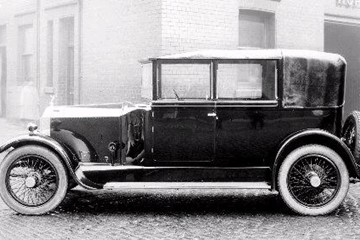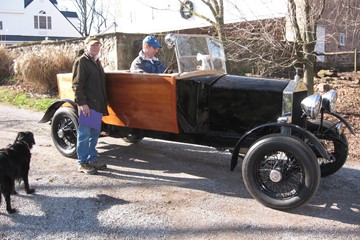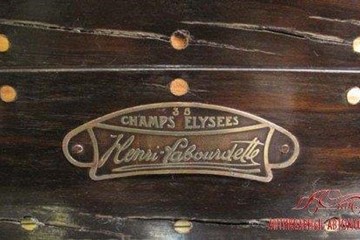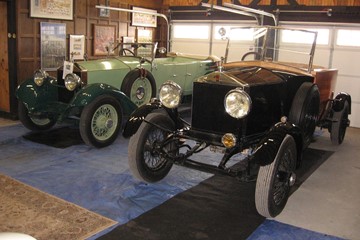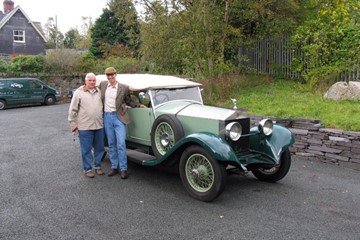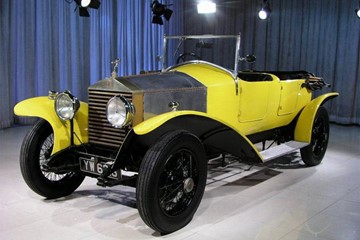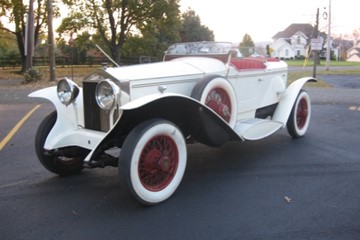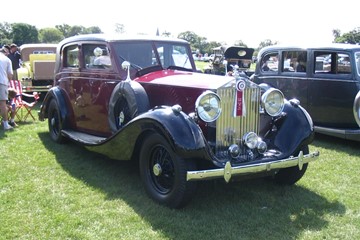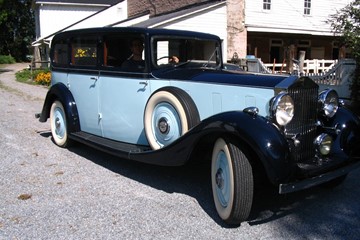Harry Tucci of USA
1923 Originally a Cockshoot Cabriolet 61H6
Bob Shaffner called and asked me to rescue 61H6 a 1923 20hp chassis that had been a gift to the Rolls Royce Foundation (USA) and was subsequently sold but never paid for. The Foundation put the car into public storage and that was never paid either. The public storage company was now auctioning the contents of the locker for the back rent. I rescued the chassis from the locker but most of the parts were still at the Foundation. Nothing from the original body existed so I decided to make a skiff body using the original specifications from Labourette’s design.
History of Rolls-Royce 20hp, Chassis 61H6, Engine G315.
The chassis number was changed from 237 to 61H6 on 7th May 1923, also handwritten on the same card was ‘214th chassis’. Raked steering and nickel fittings were specified. The levers were to be in the ‘central’ position, side lamp wiring was required for the front wings, a spare wheel carrier was to be fitted to the near side, and a luggage grid was required for the rear. A polished bonnet and an RR mascot and cap were ordered. The chassis was on test on the 6th of March 1923 and was to be fitted with an all weather body. On the 26th May it was delivered to coachbuilder Cockshoot & Co of Great Ducie Street, Manchester for G Hardy of Cheshire. It was finally tested at Cockshoot’s on 16th July 1923.
In Roy Brooks’ Cockshoot thesis (lodged at SHRMF, Paulerspury) it is noted as body/order number 964, 5th February 1923: a 20hp Rolls-Royce; enclosed cabriolet VF for G Hardy. It is noted there was one drawing in the Museum of Science and Industry, Manchester.
1925 9GIII experimental car, originally a Windovers Tourer, in 1928 it became GXL82
Goshawk was the code name given to the 20 HP experimental cars. Goshawk India refers to those cars with four-wheel braking systems. The history of 9GIII is recorded in Fasal, page 75-76, and in Ian W. Rimmer's "Rolls-Royce and Bentley Experimental Cars".
This car was built in 1925 as part of the Rolls-Royce experimental program. 9GIII was fitted with a tourer body by Windover on the 23rd of May 1925 with registration number CH 4995. It was painted gray with black wings, the color scheme for the experimental cars of that era. The car weighted 31 cwts 0 qtrs 14 lbs. It was sent to West Wittering and France where it was used to conduct various tests of component parts. During this time it most certainly was driven by Sir Henry Royce. In 1928, the car was returned to Derby and prepared for sale; the chassis was re-numbered GXL82 with engine G1575 and re-registered GU 3262. So began its long journey to be here today.
1928 Originally a Weymann - Weymann Saloon later to become a Barker tourer GYL21
GYL21 originally had engine S8J and as a Weymann Saloon coachwork by Weymann. The original owner was T. A. Braddock and later was shipped to H A Schwartz in the USA. At that time it had a Tourer body and it still has the Barker body today.
The Weymann body frames were padded and covered with self-colored fabric. Expensive bodies would use horse hair for their padding while cheaper bodies made do with cotton waste. The latter rotted very quickly if exposed to water ingress. With the development of more sophisticated body construction methods and stiffer chassis the vogue for Weymann fabric bodies ran its course by the nineteen thirties.
From 2 September 1936-7 November 1936 GYL21 was owned by Leonard Reynolds. Perhaps he converted it to a Barker tourer (Barker went bankrupt in 1938 and the assets were acquired by Hooper). GYL21 has Barker coach plates today.
When my grandchildren were young, I would take them to the garage and say “…lets go to lunch, pick a car…” inevitably they picked the Barker. Why? I always thought it was the yellow color that attracted them. Of course it was also an open tourer and fun to drive.

